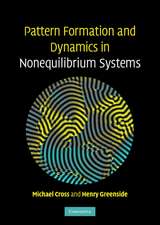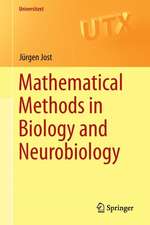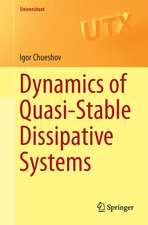Data Assimilation: A Mathematical Introduction: Texts in Applied Mathematics, cartea 62
Autor Kody Law, Andrew Stuart, Konstantinos Zygalakisen Limba Engleză Hardback – 24 sep 2015
The book is organized into nine chapters: the first contains a brief introduction to the mathematical tools around which the material is organized; the next four are concerned with discrete time dynamical systems and discrete time data; the last four are concerned with continuous time dynamical systems and continuous time data and are organized analogously to the corresponding discrete time chapters.
This book isaimed at mathematical researchers interested in a systematic development of this interdisciplinary field, and at researchers from the geosciences, and a variety of other scientific fields, who use tools from data assimilation to combine data with time-dependent models. The numerous examples and illustrations make understanding of the theoretical underpinnings of data assimilation accessible. Furthermore, the examples, exercises and MATLAB software, make the book suitable for students in applied mathematics, either through a lecture course, or through self-study.
| Toate formatele și edițiile | Preț | Express |
|---|---|---|
| Paperback (1) | 757.05 lei 38-44 zile | |
| Springer International Publishing – 22 oct 2016 | 757.05 lei 38-44 zile | |
| Hardback (1) | 806.95 lei 38-44 zile | |
| Springer International Publishing – 24 sep 2015 | 806.95 lei 38-44 zile |
Din seria Texts in Applied Mathematics
- 17%
 Preț: 368.60 lei
Preț: 368.60 lei - 17%
 Preț: 364.41 lei
Preț: 364.41 lei -
 Preț: 494.87 lei
Preț: 494.87 lei - 19%
 Preț: 510.59 lei
Preț: 510.59 lei - 17%
 Preț: 498.73 lei
Preț: 498.73 lei -
 Preț: 463.79 lei
Preț: 463.79 lei -
 Preț: 471.91 lei
Preț: 471.91 lei - 13%
 Preț: 427.17 lei
Preț: 427.17 lei -
 Preț: 447.92 lei
Preț: 447.92 lei - 19%
 Preț: 586.75 lei
Preț: 586.75 lei - 15%
 Preț: 461.28 lei
Preț: 461.28 lei -
 Preț: 404.13 lei
Preț: 404.13 lei - 17%
 Preț: 364.52 lei
Preț: 364.52 lei - 17%
 Preț: 363.10 lei
Preț: 363.10 lei - 15%
 Preț: 594.73 lei
Preț: 594.73 lei -
 Preț: 492.20 lei
Preț: 492.20 lei - 15%
 Preț: 606.82 lei
Preț: 606.82 lei -
 Preț: 406.25 lei
Preț: 406.25 lei - 15%
 Preț: 534.60 lei
Preț: 534.60 lei - 18%
 Preț: 1233.03 lei
Preț: 1233.03 lei -
 Preț: 404.13 lei
Preț: 404.13 lei - 15%
 Preț: 662.27 lei
Preț: 662.27 lei - 15%
 Preț: 511.70 lei
Preț: 511.70 lei -
 Preț: 404.89 lei
Preț: 404.89 lei -
 Preț: 399.29 lei
Preț: 399.29 lei -
 Preț: 464.00 lei
Preț: 464.00 lei - 15%
 Preț: 535.34 lei
Preț: 535.34 lei - 15%
 Preț: 681.60 lei
Preț: 681.60 lei - 15%
 Preț: 732.81 lei
Preț: 732.81 lei -
 Preț: 394.87 lei
Preț: 394.87 lei
Preț: 806.95 lei
Preț vechi: 996.23 lei
-19% Nou
Puncte Express: 1210
Preț estimativ în valută:
154.41€ • 161.62$ • 128.52£
154.41€ • 161.62$ • 128.52£
Carte tipărită la comandă
Livrare economică 26 martie-01 aprilie
Preluare comenzi: 021 569.72.76
Specificații
ISBN-13: 9783319203249
ISBN-10: 331920324X
Pagini: 242
Ilustrații: XVIII, 242 p. 61 illus., 41 illus. in color.
Dimensiuni: 178 x 254 x 20 mm
Greutate: 6.95 kg
Ediția:1st ed. 2015
Editura: Springer International Publishing
Colecția Springer
Seria Texts in Applied Mathematics
Locul publicării:Cham, Switzerland
ISBN-10: 331920324X
Pagini: 242
Ilustrații: XVIII, 242 p. 61 illus., 41 illus. in color.
Dimensiuni: 178 x 254 x 20 mm
Greutate: 6.95 kg
Ediția:1st ed. 2015
Editura: Springer International Publishing
Colecția Springer
Seria Texts in Applied Mathematics
Locul publicării:Cham, Switzerland
Public țintă
GraduateCuprins
Mathematical background.- Discrete Time: Formulation.- Discrete Time: Smoothing Algorithms.- Discrete Time: Filtering Algorithms.- Discrete Time: MATLAB Programs.- Continuous Time: Formulation.- Continuous Time: Smoothing Algorithms.- Continuous Time: Filtering Algorithms.- Continuous Time: MATLAB Programs.- Index.
Recenzii
“The mathematical style of the book is accessible to post-graduate students and combines formal mathematics with intuitive arguments and summaries of higher level results. … the book is a good guide on dynamic data assimilation. … the book suitable as a reference book for modelling on coordinates, whenever the sample space has a Euclidean vector space structure.” (Vera Pawlowsky-Glahn, zbMATH 1353.60002, 2017)
“This book provides a Bayesian perspective of data assimilation, with a focus on smoothing and filtering problems with generic dynamical models. … The authors also provide many numerical results, focusing on simple models that help the reader easily grasp the important properties of the underlying algorithms. In my opinion, this book is well suited to a graduate level course on data assimilation for applied mathematicians.” (David T. B. Kelly, Mathematical Reviews, December, 2016)
“This book provides a Bayesian perspective of data assimilation, with a focus on smoothing and filtering problems with generic dynamical models. … The authors also provide many numerical results, focusing on simple models that help the reader easily grasp the important properties of the underlying algorithms. In my opinion, this book is well suited to a graduate level course on data assimilation for applied mathematicians.” (David T. B. Kelly, Mathematical Reviews, December, 2016)
“The authors have used a collection of dynamical systems examples throughout the book. … Exercises are also given at the end of each chapter. The first half of this book would be very suitable as a graduate level textbook and concise reference on discrete time approaches to the data assimilation problem from a Bayesian point of view. The second half of the book … will primarily be of interest to researchers working in this area.” (Brian Borchers, MAA Reviews, maa.org, May, 2016)
Notă biografică
Kody Law is a Mathematician in the Computer Science and Mathematics Division at Oak Ridge National Laboratory. He received his PhD in Mathematics from the University of Massachusetts in 2010, and subsequently held positions as a postdoc at the University of Warwick and a research scientist at King Abdullah University of Science and Technology. He has published in the areas of computational applied mathematics, physics, and dynamical systems. His current research interests are focused on inverse uncertainty quantification: data assimilation, filtering, and Bayesian inverse problems.
Andrew M. Stuart is a Professor at the Mathematics Institut
e, Warwick University. He received his PhD from Oxford University, and has previously held permanent positions at Bath University and Stanford University. His primary research interests are in the field of applied and computational mathematics. He has won numerous awards, including the SIAM JDCrawford Prize and the Monroe Martin Prize in Applied Mathematics; he is also a SIAM Fellow. He has authored over one hundred journal article, and three books, including Multiscale Methods: Averaging and Homogenization (Springer, 2008, with G. Pavliotis).
Konstantinos Zygalakis is a Lecturer in Applied Mathematics at the University of Southampton. He received his PhD from the University of Warwick in 2009 and held postdoctoral positions at the Universities of Cambridge, Oxford and the Swiss Federal Institute of Technology, Lausanne before joining Southampton in 2012. In 2011 he was awarded a Leslie Fox prize (IMA UK). His research interests span from the theoretical and numerical aspects of stochastic processes and homogenization theory to applications in mathematical biology.
Andrew M. Stuart is a Professor at the Mathematics Institut
e, Warwick University. He received his PhD from Oxford University, and has previously held permanent positions at Bath University and Stanford University. His primary research interests are in the field of applied and computational mathematics. He has won numerous awards, including the SIAM JDCrawford Prize and the Monroe Martin Prize in Applied Mathematics; he is also a SIAM Fellow. He has authored over one hundred journal article, and three books, including Multiscale Methods: Averaging and Homogenization (Springer, 2008, with G. Pavliotis).
Konstantinos Zygalakis is a Lecturer in Applied Mathematics at the University of Southampton. He received his PhD from the University of Warwick in 2009 and held postdoctoral positions at the Universities of Cambridge, Oxford and the Swiss Federal Institute of Technology, Lausanne before joining Southampton in 2012. In 2011 he was awarded a Leslie Fox prize (IMA UK). His research interests span from the theoretical and numerical aspects of stochastic processes and homogenization theory to applications in mathematical biology.
Textul de pe ultima copertă
This book provides a systematic treatment of the mathematical underpinnings of work in data assimilation, covering both theoretical and computational approaches. Specifically the authors develop a unified mathematical framework in which a Bayesian formulation of the problem provides the bedrock for the derivation, development and analysis of algorithms; the many examples used in the text, together with the algorithms which are introduced and discussed, are all illustrated by the MATLAB software detailed in the book and made freely available online.
The book is organized into nine chapters: the first contains a brief introduction to the mathematical tools around which the material is organized; the next four are concerned with discrete time dynamical systems and discrete time data; the last four are concerned with continuous time dynamical systems and continuous time data and are organized analogously to the corresponding discrete time chapters.
This book isaimed at mathematical researchers interested in a systematic development of this interdisciplinary field, and at researchers from the geosciences, and a variety of other scientific fields, who use tools from data assimilation to combine data with time-dependent models. The numerous examples and illustrations make understanding of the theoretical underpinnings of data assimilation accessible. Furthermore, the examples, exercises and MATLAB software, make the book suitable for students in applied mathema
tics, either through a lecture course, or through self-study.
The book is organized into nine chapters: the first contains a brief introduction to the mathematical tools around which the material is organized; the next four are concerned with discrete time dynamical systems and discrete time data; the last four are concerned with continuous time dynamical systems and continuous time data and are organized analogously to the corresponding discrete time chapters.
This book isaimed at mathematical researchers interested in a systematic development of this interdisciplinary field, and at researchers from the geosciences, and a variety of other scientific fields, who use tools from data assimilation to combine data with time-dependent models. The numerous examples and illustrations make understanding of the theoretical underpinnings of data assimilation accessible. Furthermore, the examples, exercises and MATLAB software, make the book suitable for students in applied mathema
tics, either through a lecture course, or through self-study.
Caracteristici
Provides a unified mathematical framework for the systematic study of data assimilation Opens the area of data assimilation to mathematical and computational scientists Explains how to think about blending data with time-dependent models, a central requirement in almost all areas of human endeavor












